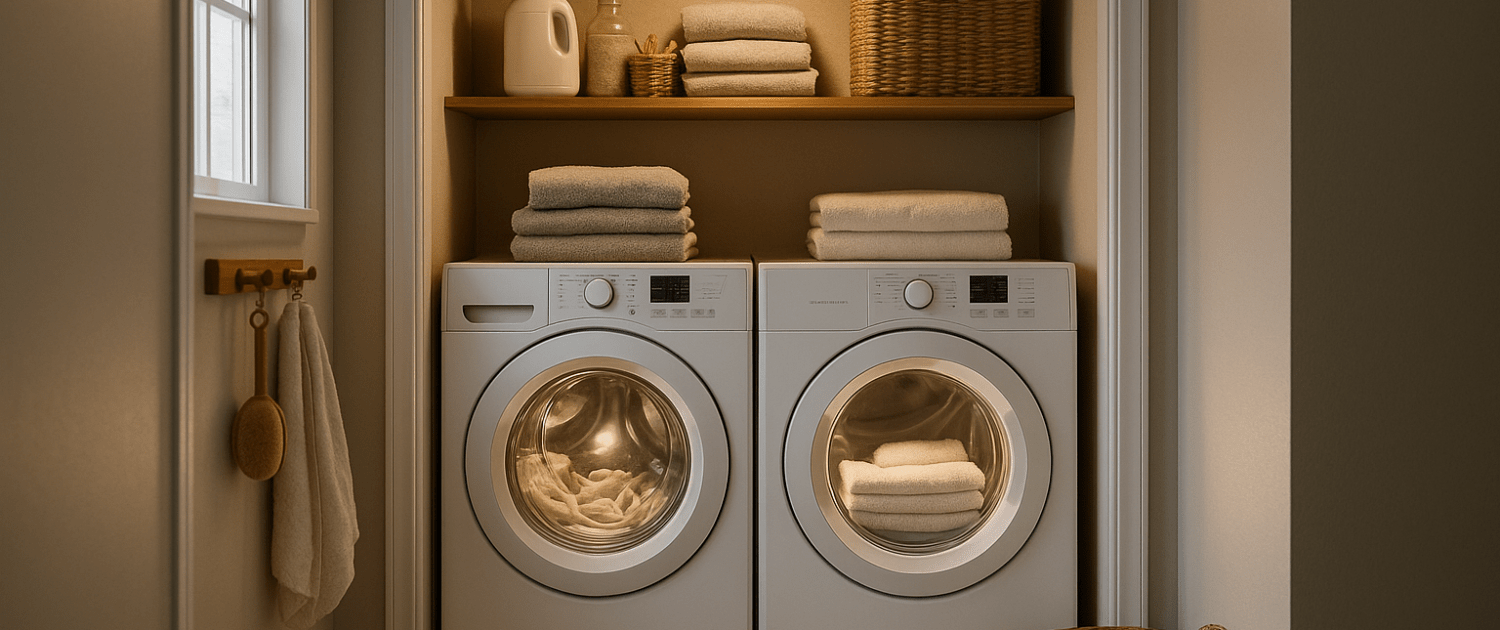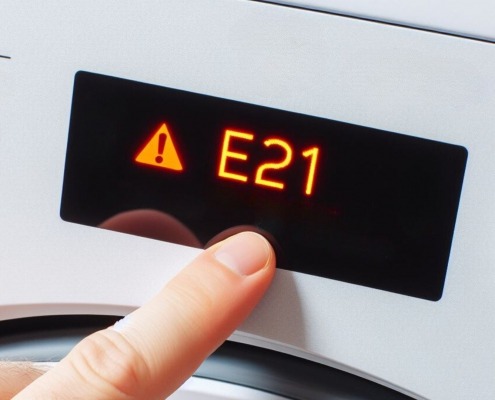LG Front Load Washer Doesn’t Spin? LE Error Code Test and Fix
Steven E / Tuesday June 17, 2025
Is your LG front-load washer refusing to spin and showing the LE error code? This usually points to a motor issue, often caused by an overloaded drum or a faulty hall sensor. If you have a gas or electric model, we’ll walk you through troubleshooting steps to get it running again.
If you need any replacement parts for your LG washer, you can enter your model number at AppliancePartsPros.com to order them. Most orders arrive in just two business days, and we have thousands of free guides to show you how to install your new parts.
The information in this article may not apply to your specific appliance model. We recommend consulting your manufacturer’s documentation or contact us with any questions.
What you need
- Phillips screwdriver
- Multimeter
- Socket wrench with an extension
- Plastic mallet
- 17 mm and 10 mm socket heads
- Flatblade screwdriver
Safety precautions
When working on any appliance, remember to keep safety first. Here are some tips to keep in mind:
- Always power off and unplug your appliance or switch off the circuit breaker before you attempt any maintenance or replacement work. This keeps you safe by eliminating any risk of electric shock.
- If the appliance has recently been used, give it plenty of time to cool down before working on it.
- Take your time while working to prevent accidents and personal injuries. Rushing is the enemy of precision.
- Work in a well-lit area so you can see and access appliance parts.
- Keep your workspace free of clutter and other obstacles. Keep children and pets away from the work area.
- Never work on internal parts with wet hands. Make sure the work area is completely dry.
- Check the user manual to see if there are specific installation or safety instructions related to your appliance or replacement part.
- Be gentle when handling or removing parts. Excessive force might damage the appliance or cause personal injury.
- Wear insulated work gloves to protect your hands from sharp metal parts and debris.
- When working with wires, avoid touching any exposed wires or terminals. If you need to touch a wire, use a non-conductive tool or wear insulating gloves to prevent electrical shock.
- Always take photos or make a note of wiring terminals or other connections before disconnecting them to make reassembly easier.
- Don’t test live voltage with a multimeter if you’re unfamiliar with how to prevent short-circuiting.
- Consider wearing safety glasses and/or a dust mask when working with chemicals, dust or a large amount of debris to prevent irritation or injury.
- Turn off the water supply at the outlet before beginning repairs. Keep towels ready to catch any residual water in the system when removing parts.
How to troubleshoot an LG front-load washer that won’t spin and displays the LE error code
Follow these steps to diagnose and fix the issue, ensuring your washer runs properly again.
Step 1. Access the rotor positioning sensor (RPS)
- Unplug the washer.
- Turn off the water supply.
- Drain excess water if necessary using the drain hose near the pump filter.
- Check for an overloaded load and remove excess laundry.
- Reset the washer by unplugging it for 10 minutes and restarting.
- Place a towel under the water inlet hoses.
- Use pliers to loosen and remove the inlet hoses.
- Remove the rear access panel by unscrewing four Phillips screws, then slide it up and pull it off.
- Locate the RPS harness at the back of the washer near the stator.
- Identify the four-wire plug with White, Blue, Grey, and Red wires.
LIVE VOLTAGE WARNING: For this test, the washer needs to be plugged in and powered on. Please be very careful to protect yourself from electric shock, which has the potential to cause serious injuries. Don’t ever test live voltage if you’re uncomfortable using a multimeter.
- Set the multimeter to Volts DC (V with two lines on top).
- Insert probes into White and Grey terminals.
- Plug in the washer but do not press Start.
- Press the Power button.
- Check for 10-15 VDC. If the reading is 0 VDC, test the motor harness.
- If the harness is good but the voltage is 0, replace the Main PCB.
Step 2. Test the RPS signal output
- Move the probe from White to Blue while keeping the second probe on Grey.
- Manually rotate the rotor and observe for a pulsing 10+ VDC.
- Move the probe from Blue to Red and repeat the test.
- If both tests show pulsing 10+ VDC, the RPS is good.
- If either test shows steady or no voltage, replace the RPS.
Step 3. Test the resistance for RPS
NOTE: Generally, for every 1 degree in temperature difference, 2 Ohms could be added or subtracted. If the temperature in your home is cooler, resistance would be subtracted.
- Unplug the washer.
- Set the multimeter to KOhms (Ω, horseshoe sign).
- Test resistance between White and Red and then White and Blue.
- If the reading is not between 8-12 KOhms, replace the RPS.
Step 4. Test the motor harness
- Unplug the washer.
- Use a 17mm socket wrench and mallet to loosen and remove the center bolt of the rotor.
- Wiggle and pull off the rotor carefully.
- Locate the motor harness connected to the stator (three-wire plug) and RPS (four-wire plug).
- Find the motor harness connectors secured in a plastic bag inside the cabinet.
- Set the multimeter to continuity mode (Wi-Fi symbol).
- Insert one probe into the Blue wire at the disconnect plug and the other into the Blue wire at the Stator plug.
- If there is no continuity, repair or replace the harness.
- Repeat the continuity test for the Yellow and Red wires.
- Test all four RPS wires for continuity in the same manner.
- If any wire lacks continuity, replace the motor harness.
Step 5. Test the stator
- Unplug the washer.
- Locate the three-wire stator plug.
- Set the multimeter to Resistance mode (Ω, horseshoe sign).
- Insert one probe into the Blue wire connector and the second into the Red slot.
- Check for a reading between 5-15 Ohms.
- Move the probe from Blue to Yellow and check for the same reading.
- Move the probe from Red to Yellow and check for the same reading.
- If any of the windings are out of range, replace the stator.
Step 6. Inspect the rotor
- Visually inspect the rotor for cracks, missing magnets, or damage.
- If the rotor is damaged, replace it.
Step 7. Test the main PCB
- Set the multimeter to Volts DC (V with two lines on top).
- Insert probes into White and Grey terminals on the RPS plug.
- Plug in the washer, but do not press Start.
- Press the Power button.
- Check for 10-15 VDC. If the voltage is 0, unplug the washer and test the motor harness for continuity.
- If the harness is good but voltage is 0, replace the Main PCB.
- Reassemble the washer.
- Secure all connectors properly.
- Plug in the washer and test the spin cycle.
- If the issue persists, seek professional repair assistance.
More DIY resources
Thanks for sticking with us! We hope this guide got your LG washer back up and running. If you’ve got other appliance repairs on your list, take a look at our other guides and videos for some more help. When you’re ready to order new parts, just grab your model number and head over to AppliancePartsPros.com. You can chat with a pro, check out our DIY blog, view diagrams and more. Don’t forget to subscribe on YouTube and connect with us on Facebook, X and Instagram!
With nearly a decade of experience in providing top-notch customer service regarding appliance parts and repair, Steven enjoys sharing practical advice, troubleshooting tips, and interesting information to help readers stay informed.





